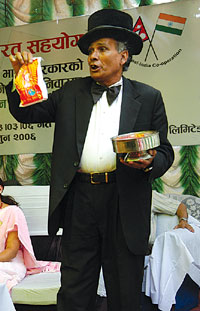|
|
When goitre was endemic in Nepal, until as recently as the 1980s, the bulge in the throat caused by iodine deficiency was regarded as a sign of beauty. Young men and women in the high Himalays couldn't get married if they didn't have a goitre.
Almost everyone across the mountains was affected by iodine deficiency, making cretinism common. But a successful 30-year effort that combined government, private sector and aid agencies has all but wiped out visible goitre in Nepal.
The percentage of Nepali households with access to iodised salt is now 90 percent-much higher than India (50 percent) or Pakistan (17 percent). In fact, Nepal is the only country in the south and southeast Asia regions that has such high iodised salt use.
"This is a model for a public distribution system for essential commodities," says Parmeswor Mahaseth of Salt Trading Corporation (STC), which is involved in the iodised salt program, "it can be replicated elsewhere, and in Nepal we can use the same method to fortify foods with iron and other micronutrients."
Part of the reason for the success is that STC is the sole distributor for subsidised and iodised salt, ensuring quality and low prices. The subsidy is back-stopped by the Ministry of Health, the Indian government and UNICEF.
Salt imported from India has to be re-iodised, since iodine is volatile and lost after prolonged storage. STC runs iodisation and packaging plants in Birtamod, Biratnagar, Janakpur, Bhairawa, Narayanghat, and Nepalganj.
The problem now is that non-edible salt for industrial use is being smuggled into Nepal from India. These have below-threshold levels of sodium chloride and are unfit for human consumption, raising the danger of goitre resurfacing.
Salt from lakes in Tibet has been traditionally consumed in northern Nepal, but it lacks iodine. STC has set up an iodisation plant for Tibetan salt at the Chinese border in Hilsa of Humla and plans a similar one in Dolpo.
"Iodine deficiency needs constant vigilance to ensure distribution and quality control, otherwise the disorder could be endemic again," Mahaseth says.
But it is also a question of economics. The government spends more than Rs 150 million a year subsidising Nepali salt, making it among the cheapest in South Asia. Salt in Nepal costs Rs 10 per kg, it is Rs 16 in India, Rs 17 in Pakistan, Rs 20 in Bangladesh, and Rs 23 in Sri Lanka.
"If the subsidy is lifted, or if private distributors are allowed in, the price of salt will double overnight," says Mahaseth. Donor sources agree, saying the iodisation, subsidy, and distribution model works. "Why fix something that ain't broke?" says one Kathmandu donor official. Yet business interests in Nepal are putting pressure on the seven-party government to deregulate the import, wholesale, and distribution of salt.
Ninety percent of Nepali women are also anaemic because they don't get enough iron in their diet. With donor support, the government is now looking at double-fortification of salt to address the needs of Nepali mothers. Alternatively, wheat and flour could be fortified with iron.
Nepalis consume 150,000 tons of salt every year. About 65 percent of the population has access to adequately iodised salt, 18 percent gets inadequately iodised salt, and 17 percent of Nepalis still consume non-iodised salt.



